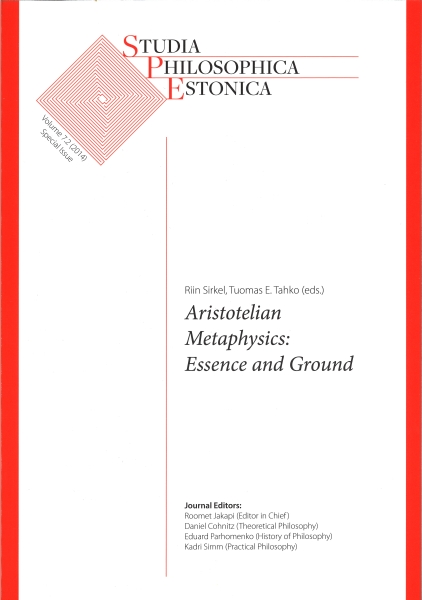E.J. Lowe on the Unity Problem
DOI:
https://doi.org/10.12697/spe.2014.7.2.10Keywords:
substance, kind, nature, essentialism, essence, propertiesAbstract
Some properties are connected in a perspicuous and unproblematic way. For instance, the possession of shape clearly entails the possession of size (and vice versa). In other cases the connection is not so perspicuous. For instance, assuming that the precise rest mass and negative charge of an electron are both among its fundamental intrinsic properties, what links them, given that those properties are inherently separable? (Their separability is apparent from the fact that other kinds of particle have the same mass as an electron but a different charge, or the same charge but a different mass.) Given the inherent separability of those properties, what explains their conjunction in this case? Oderberg (2007, 2011) calls this the "unity problem", and attempts to solve it have issued from assorted schools of thought within both substance ontology and the metaphysics of natural kinds. One of the more significant of these solutions is proffered by E.J. Lowe as part of his four-category ontology. Here I explicate his solution, raise a possible objection, and suggest a reply.
Downloads
References
Armstrong, D. (1989). Universals: An Opinionated Introduction, Westview, Boulder.
Armstrong, D. (1997). A World of States of AÅ¡airs, Cambridge University Press, Cambridge.
Broackes, J. (2006). Substance, Proceedings of the Aristotelian Society 106: 131-166.
Clarke, W. (2001). The One and the Many: A Contemporary Thomistic Metaphysics, University of Notre Dame Press, Notre Dame.
Connell, R. (1966). Matter and Becoming, The Priory Press, Chicago.
Dumsday, T. (2010). Natural kinds and the problem of complex essences, Australasian Journal of Philosophy 88: 619-634.
Dumsday, T. (2012). Dispositions, primitive activities, and essentially active objects, Pacific Philosophical Quarterly 93: 43-64.
Ellis, B. (2001). Scientific Essentialism, Cambridge University Press, Cambridge.
Ellis, B. (2002). The Philosophy of Nature: A Guide to the New Essentialism, McGill-Queen’s University Press.
Ellis, B. (2005). Universals, the essential problem and categorical properties, Ratio 18: 462-472.
Gorman, M. (2005). The essential and the accidental, Ratio 18: 276-289.
Heil, J. (2012). Are four categories two too many?, in T. Tahko (ed.), Contemporary Aristotelian Metaphysics, Cambridge University Press, Cambridge, pp. 105-125.
Hoffman, J. and Rosenkrantz, G. (1997). Substance: Its Nature and Existence, Routledge, London.
Koslicki, K. (2013). Substance, independence, and unity, in E. Feser (ed.), Aristotle on Method and Metaphysics, Palgrave Macmillan, New York, pp. 169-195.
Kronen, J. (1991). Essentialism old and new: Suarez and Brody, Modern Schoolman 58: 123-151.
LaBossiere, M. (1994). Substances and substrata, Australasian Journal of Philosophy 72: 360-370.
Loux, M. (1974). Kinds and the dilemma of individuation, Review of Metaphysics 27: 773-784.
Loux, M. (1978). Substance and Attribute: A Study in Ontology, Reidel, Dordrecht.
Loux, M. (2002). Metaphysics: A Contemporary Introduction, 2nd edn, Routledge.
Lowe, E. (1989). Kinds of Being: A Study of Individuation, Identity and the Logic of Sortal Terms, Blackwell, Oxford.
Lowe, E. (1997). Ontological categories and natural kinds, Philosophical Papers 26: 29-46.
Lowe, E. (1998). Form without matter, Ratio 11: 214-234.
Lowe, E. (2000). Locke, Martin, and substance, Philosophical Quarterly 50: 499-514.
Lowe, E. (2001). Dispositions and laws, Metaphysica 2: 5-23.
Lowe, E. (2006). The Four-Category Ontology: A Metaphysical Foundation218 E.J. Lowe on the Unity Problem for Natural Science, Oxford University Press, Oxford.
Lowe, E. (2008). Two notions of being: Entity and essence, Philosophy 83: 23-48.
Lowe, E. (2009). Ontological dependence, in E. N. Zalta (ed.), Stanford Encyclopedia of Philosophy, fall 2009 edn. URL: http://plato.stanford.edu/archives/fall2009/entries/dependence-ontological/
Lowe, E. (2012). A neo-Aristotelian substance ontology: Neither relational nor constituent, in T. Tahko (ed.), Contemporary Aristotelian Metaphysics, Cambridge University Press, Cambridge, pp. 229-248.
Lowe, E. (2013). Neo-Aristotelian metaphysics: A brief exposition and defense, in E. Feser (ed.), Aristotle on Method and Metaphysics, Palgrave Macmillan, New York, pp. 196-205.
Macdonald, C. (2005). Varieties of things: Foundations of Contemporary Metaphysics, Blackwell.
Martin, C. (1980). Substance substantiated, Australasian Journal of Philosophy 58: 3-10.
Mumford, S. (2004). Laws in Nature, Routledge, New York.
Oderberg, D. (2007). Real Essentialism, Routledge, London.
Oderberg, D. (2011). Essence and properties, Erkenntnis 75: 85-111.
Pasnau, R. (2011). Metaphysical Themes: 1274-167 Oxford University Press, Oxford.
Psillos, S. (2009). Knowing the Structure of Nature: Essays on Realism and Explanation, Palgrave Macmillan, New York.
Scaltsas, T. (1994). Substances and Universals in Aristotle’s Metaphysics, Cornell University Press, Ithaca.
Sider, T. (2006). Bare particulars, Philosophical Perspectives 20: 387-397.
Williams, S. and Charles, D. (2013). Essence, modality, and the master craftsman, in E. Feser (ed.), Aristotle on Method and Metaphysics, Palgrave Macmillan, New York, pp. 121-145.

